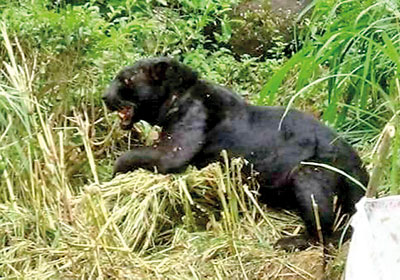News
Expert raises questions after rescued rare black leopard dies
The autopsy on the black leopard rescued from a snare in Nallathanniya earlier this week, and which died on Friday, was carried out at the University of Peradeniya.
The results were not available at the time of going to press, but officials said it had deep injuries on its neck at the time it was freed from the trap.

The rare black leopard caught in the snare
The fully grown male was found in the snare on Tuesday. A prominent marking on its tail made it “highly likely” that this was the same black leopard spotted in the Central Hills earlier this year, said Tharaka Prasad, Director of Wildlife Health at the Wildlife Conservation Department (WCD).
Authorities chose not to return the leopard to the wild after seeing deep cuts on its neck sustained from a struggle to free itself from the vicious entrapment. They feared it would lead to severe blood circulation impairment.
The location of the wounds would have made it impossible for the leopard to lick itself, Dr Prasad said. It was taken to the Udawalawe veterinary hospital which was better equipped to deal with such severe wounds.
The WCD claimed it had taken measures to minimise human contact with the animal to minimise stress that would have exacerbated the damage. Once in confinement, monitoring was mostly done through cameras while human interaction was restricted to feeding and administration of medicines.
However, doctors noticed a marked deterioration in its condition on Thursday evening, leading them to administer saline. This, too, did not help and the animal got weaker before dying on Friday morning.
Rukshan Jayewardene, an expert on leopards, said an autopsy was “very advisable” for the sake of transparency. The black leopard was a rare phenomenon, a genetic anomaly caused by a double recessive gene which comes from both parents. A female was also found in a snare at Deniyaya in 2011. It had died of strangulation from the trap.
Mr Jayewardene expressed concern over the capacity of Sri Lankan authorities to handle situations of this nature. “We need faster, rapid response, better trained personnel and equipment, if we are to protect the natural resources of this country,” he said.
He pointed out that the longer the animal was in the snare, the higher the chances of it dying. While there was a protocol for trapped leopards, he questioned the manner in which it was enforced.
Crowds had been allowed to gather around the traumatised animal, even after the authorities reached it, Mr Jayewardene pointed out: “Why wasn’t protocol followed?” he asked.
The protocol maps out the role of every member of potential rescue missions including the police. The OIC of the nearest police station should have a copy. Director General of the WCD Chandana Sooriyabandara admitted that the protocol calls for removal of civilians from the area. However, footage of the leopard being freed showed the presence of people it.
The vets arrived three to four hours within the initial report being received, Mr Sooriyabandara said. An arrest has been made and legal action will be taken under the Flora and Fauna Ordinance. The offences surrounding the incident were punishable and non-bailable.


